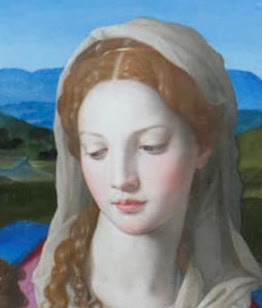The marmoreal and sculptural beauty of Agnolo di Cosimo’s (il Bronzino) depictions of the Madonna never fail to astonish me. He creates a sort of paragone confrontation sui generis, which is to say, that within his own paintings he confronts the debate between painting and sculpture (vide infra).
Herewith for your admiration is the sublimely beautiful face of the Virgin Mary in the Louvre version of Bronzino’s Holy Family with St. Anne and the infant St John.
Take a look here as well at the Kunsthistorisches version.
Astonishing beauty.
I would love to know who was Agnolo’s model for these portrayals of Mary, or did he craft these exquisite visages purely from his own conception of perfect beauty?
“In an art-historical context, the Italian word paragone (“comparison”, pl. paragoni) refers to a number of theoretical discussions that informed the development of artistic theory in 16th-century Italy.
“These include the comparison between differing aesthetic qualities of central Italian and Venetian schools of painting (the so-called disegno/colore paragone) and whether painting or literature was the more convincing and descriptive medium.
“But the term paragone most often refers to the debate about the relative merits of painting and sculpture during the Renaissance period. This debate unfolded primarily in Italy but also in the Low Countries (Flanders and the Netherlands) in writings about art and artworks themselves, and informs our understanding of some of the most significant art and artists of the Renaissance.”
Ref: Oxford Art Online
The Holy Family with St Anne and the infant St John
Agnolo di Cosimo di Mariano, detto il Bronzino
1550
Louvre



No comments:
Post a Comment